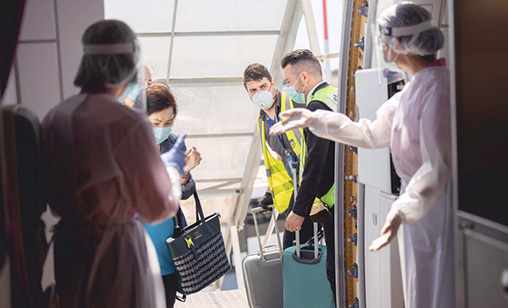News Backgrounder
University study argues random boarding reduces risk of inflight COVID-19 transmission
July 1st 2020
Preliminary computer simulations conducted by researchers at Embry-Riddle Aeronautical University in Florida suggest random boarding of aircraft, rather than back-to-front boarding – a procedural response to the COVID-19 pandemic – may reduce exposure rates to the COVID-19 virus by about 50%. Read More »
In a paper co-authored by Ashok Srinivasan of Florida State University and Dr. Sirish Namilae, associate professor of Aerospace Engineering at Embry-Riddle, confirmed the findings “suggested airlines either should revert to their earlier boarding process or adopt the better random process”. Namilae, whose past studies have shown pedestrian dynamics in airport security lines and during boarding and deplaning may impact infection rates, began researching how viruses spread during the Ebola outbreak of 2017.
 |
Critical to the research, he said, is an understanding of how molecules travel. “While back-to-front boarding has been instituted by some airlines to try and reduce contact between people, our simulations show high density clusters can form as people stow their luggage while other passengers are still pushing toward the back of the aircraft,” he said.
“We hope our research will prove useful to the airline industry in navigating the current health crisis.”
Contact points in the study are defined by a “person-minute” of contact or the number of minutes a person stands within six feet of proximity from someone else while boarding an aircraft. The more these person-minutes were recorded in each of the team’s roughly 16,000 simulations — simulations that varied the parameters of walking speed, proximity, number of people, etc., then ran the data through a Frontera supercomputer — the higher the infection probability.
The simulations were then tested on several boarding patterns: front-to-back, back-to-front, through six boarding zones and random boarding through one zone.
“It turns out, the one-zone, random boarding model eventually results in a lower number of contacts,” Namilae said. “Other patterns tend to increase the time a passenger waits in close proximity to fellow travelers.”
In simulations that assume full capacity of an A320, 43,000 person-minutes of contacts were recorded in the random boarding model compared with 60,000 person-minutes for six-zone boarding, 90,000 person-minutes for back-to-front boarding and even higher for the front-to-back boarding pattern.
“Our analysis indicates airlines that changed to a back-to-front boarding policy erred, exposing passengers to substantially higher infection risk than their original procedures,” said Srinivasan.
“This result shows that good intention is not a substitute for good science when it comes to determining policies.”
The policy of some airlines to keep middle seats unoccupied, he added, proved effective in significantly reducing infection risk as proven by the team’s simulations. They included scenarios where middle seats were left occupied or empty. “The problem is how long can airlines afford to fly with empty seats?”
Namilae asked, and added economics are a consistent consideration in these simulations.
Transporting passengers in multiple smaller aircraft, for example, was shown to pose a lower risk of infection to passengers than if one larger aircraft was used. The challenge is finding a middle ground and for Namilae and his team, that conversation has to begin with the boarding process. “There’s evidence of a lot of diseases, such as tuberculosis and SARS, being transmitted on airplanes and in air travel,” Namilae said. “Boarding is one of the critical aspects of air travel that contributes to the spread.”